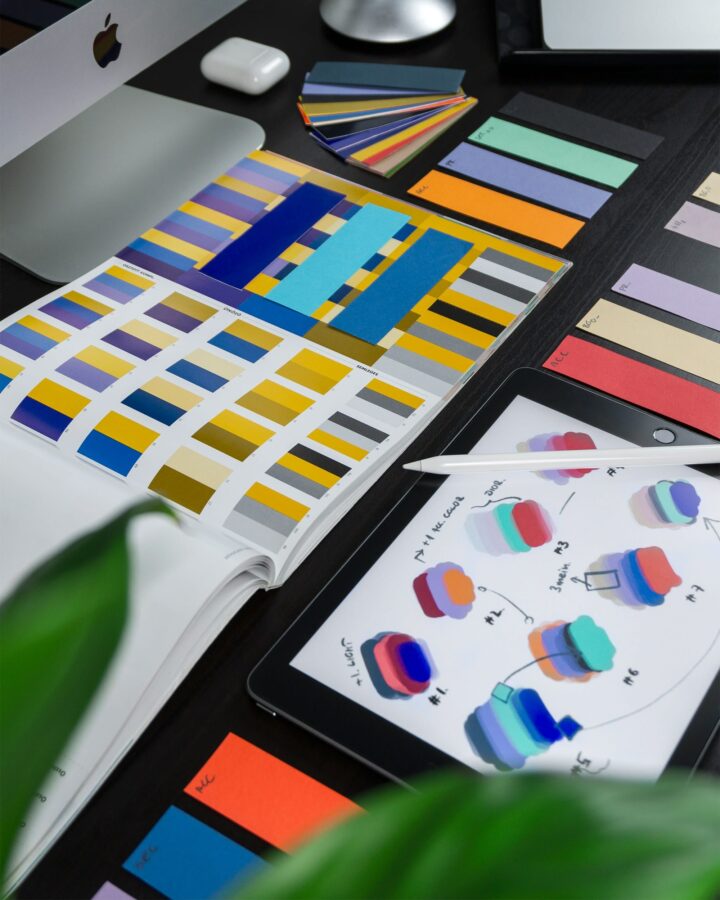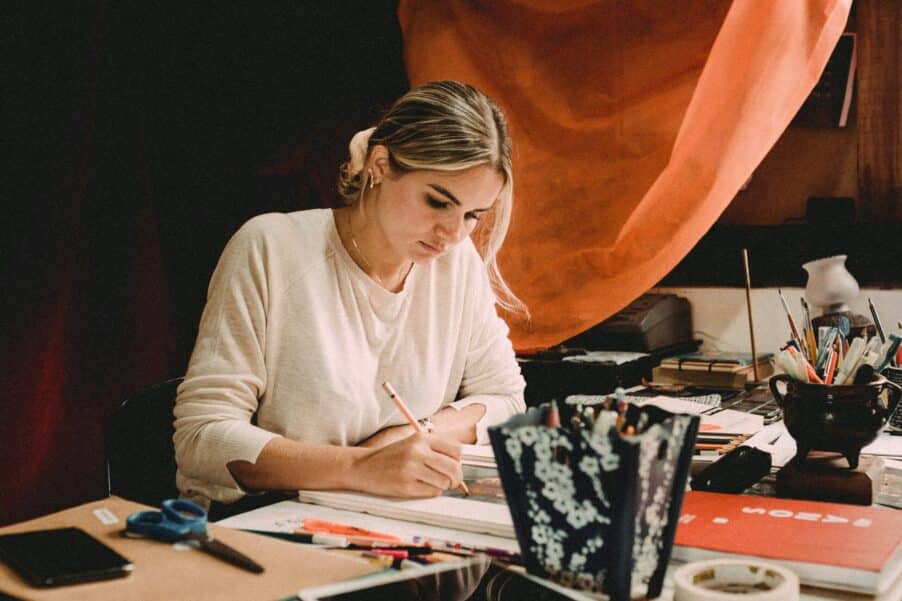Acompáñanos mientras profundizamos en el papel fundamental que desempeña la marca personal para los creadores, y desentrañamos cómo los artistas pueden desarrollar su identidad única, a la vez que comunican hábilmente su visión para cautivar a su público, establecer mejores relaciones con los clientes y conseguir las actuaciones que desean.
Este artículo trata de la definición de una marca personal y de cómo maximizar los beneficios de la sinceridad, la narración de historias y la definición de tus valores en toda tu presencia en Internet y en tus interacciones personales.
Aspectos básicos de la marca personal
Quizá hayas leído mucho sobre la marca personal. O puede que todo esto sea nuevo para ti. En cualquier caso, este artículo te servirá de baremo para ver cómo estás, y te sugerirá posibles mejoras que puedes introducir en tu marca.
Tu marca es lo que te hace, bueno, ¡tú! No te atasques con lo que tienes que incluir, como premios o galardones. Esas cosas están bien, pero no son lo que buscan realmente los clientes potenciales (y los actuales). Lo que la gente quiere es conocerte mejor, como artista creativo, y saber cómo tu personalidad, tu visión y tus valores influyen en lo que haces.
Pero antes de entrar en todo eso, definamos primero qué es exactamente una marca personal.
Definir la marca personal
Cuando piensas en la marca personal, probablemente tu mente salte a la cohesión de un logotipo y a cómo se relaciona con tu estilo de trabajo. Aunque un buen logotipo puede ayudar a la gente a identificar tu marca, la marca personal es mucho más.
La marca personal es el proceso de definir y promover lo que representas como individuo, y en este caso como profesional creativo. Es una culminación de las experiencias, habilidades y valores que te diferencian, como una serie de huellas dactilares creativas que vas dejando aquí y allá a lo largo de tu trabajo y estilo de comunicación.
Después de dedicar tiempo a determinar tu marca personal, ésta se reflejará no sólo en cómo que creas, sino los sentimientos evocados en tu público a través de tu estilo creativo, y toda la magia innata a tu obra única.
Singularidad, Autenticidad, Énfasis
A menudo la gente no da suficiente crédito a sus clientes potenciales o actuales cuando se trata de olfatear lo genuino o auténtico que es alguien. Claro que hay veces en que al cliente no le importa mucho, pero no es el caso cuando se trabaja en industrias creativas.
Esencialmente, tu público necesita que seas franco al mostrar tus valores, por qué son importantes y cómo se entrelazan con lo que haces: eso es lo que crea tu huella digital creativa única, genuina y auténtica.
Si puedes comunicar claramente lo que pretendes, tus clientes sentirán que te entienden antes de conocerte o interactuar contigo, lo que hará que les resulte mucho más fácil trabajar contigo.

Construir tu identidad creativa
Cultivar tu identidad creativa única puede parecer aburrido. Al empezar, muchos creadores prefieren dejar eso a un lado y centrarse directamente en crear más arte, con la esperanza de que la gente entienda de dónde vienen sin necesidad de explicaciones ni claridad. Esto ocurre ocasionalmente; pero depender únicamente de esto no sólo es esperanzador, sino también un poco arriesgado, ya que no se sabe si las personas que realmente resuenan contigo tienen tiempo para sumergirse en tu trabajo mientras buscan a su alrededor creativos con los que trabajar.
Recuerda que el objetivo de este proceso es que la gente sienta una conexión, identifique un objetivo compartido y tenga ganas de interactuar contigo. No necesitas técnicas de venta babosas; en lugar de eso, elabora y comunica una identidad creativa clara, y construye relaciones auténticas con tus clientes. Sé transparente, abierto y vulnerable con ellos, al tiempo que te muestras seguro y fuerte dentro de tu propio trabajo.
Identificar y encarnar los valores fundamentales
Si aún no te has tomado el tiempo necesario para determinar tus valores artísticos, ahora es el momento. El autodescubrimiento es algo en lo que la mayoría de la gente trabaja durante toda su vida, con distintos métodos, destinos y resultados.
Independientemente de lo mucho o poco que hayas repasado esto a lo largo de tu vida, ahora es un buen momento para la autorreflexión. Hay varias herramientas que puedes utilizar para ayudarte a vivir tus valores fundamentalespero puedes empezar reflexionando sobre estas preguntas:
- ¿Qué momentos te han aportado más alegría, satisfacción o sentido de finalidad?
- ¿Qué priorizas en la vida: a qué dedicas tu tiempo, tu energía y tus recursos?
- ¿Qué te inspira y te hace sentir más profundamente?
- ¿Qué dificultades has tenido en el camino?
- ¿Qué es tan importante para ti que no es negociable?
Éstas son sólo algunas de las muchas preguntas que podrías hacerte. Hacerte preguntas y profundizar en tu propia alma creativa es una parte crucial de los cimientos necesarios para la auténtica marca personal y el crecimiento personal.
Si no estás seguro de qué valores son importantes para ti, es difícil que los demás comprendan de dónde vienes, quién eres y cómo encarnas los valores que te son cercanos y queridos. Si la gente tiene que indagar para saber más de ti, es muy posible que pierdas su atención antes de que encuentren esa información.
En resumen, haz que tus valores sean altos, claros y accesibles para que los demás encuentren lo que representas. Esto ayuda a aliviar cualquier ansiedad por conocerte y desarrolla una fuerte identidad para tu marca.

Comunicar tu marca con eficacia
La comunicación eficaz de tu marca consiste menos en explicar a la gente lo que haces, y más en mantener una conversación genuina, relacionarte con otras personas y establecer una conexión.
Recuerda: cuando interactúas con clientes, básicamente les estás pidiendo que te confíen su dinero, su tiempo y su energía. Es fácil tropezar o centrarse demasiado en dar un discurso de ascensor rápido. Es muy posible que el éxito ocurra así, lo cual forma parte de la experiencia de aprendizaje.
Sin embargo, si quieres longevidad y tranquilidad en una profesión creativa, dejar atrás las técnicas de venta y tener clientes que se sientan como amigos garantiza que la gente no se sienta utilizada o manipulada por alguna táctica de venta. Además, gustarás más a las personas con las que interactúes, lo que puede dar lugar a referencias con otras galerías, negocios o con sus amigos y familiares.
Crear una marca identificable: Logotipos, fuentes y colores
Cuando se utilizan bien, tus elecciones de color y tipo de letra pueden ayudar a establecer el tono de tu marca: desde formal hasta amistoso o poco convencional. Pero una combinación que no coincida con el tono y los valores de tu marca puede crear una sensación inconexa y distraer potencialmente a seguidores y clientes potenciales.
Cuando pienses en los tipos de letra, los colores y el diseño de tu logotipo, ten en cuenta la presentación de tu marca en su conjunto. Ayuda pensar en ellos como acentos de fuentes más convencionales y fondos sencillos blancos o de color claro en tu sitio web, boletines de correo electrónico y otras comunicaciones públicas.
Por ejemplo, cuando pienses en cómo trasladar tu marca a tu sitio web, reserva tus fuentes especializadas para el logotipo de tu sitio y los textos de la cabecera, y luego selecciona una fuente complementaria fácil de leer para utilizar en todo el sitio. El cuerpo del texto de tu sitio -o de los boletines por correo electrónico- debe permitir que los visitantes se centren en el mensaje que estás compartiendo en lugar de en el tipo de letra.
Decidir cómo utilizar los colores puede ser complicado: para que tu trabajo destaque y el cartera en línea sea accesible al mayor número posible de visitantes, los colores principales deben ser generalmente neutros con contraste. En su lugar, considera la posibilidad de utilizar los colores de tu marca en tu logotipo y como acentos en el diseño de tus páginas, tanto para tu sitio web y boletines informativos como para cualquier material impreso que crees para tu negocio. Lo ideal es que los colores que mejor se adapten a tu marca también coordinen con la mayoría de tus trabajos destacados.
Coherencia entre plataformas
Hoy en día, la gente es conocida por tener períodos de atención más cortos, lo que puede traducirse en una menor tolerancia a las narraciones demasiado complicadas.
Por ello, la coherencia en todas tus plataformas es crucial. Tus clientes más fieles aprenderán a reconocer tu huella creativa en tu trabajo si adoptas esta coherencia de forma verdadera y clara. La coherencia no consiste sólo en cómo o qué publicas, sino en mantener un tono coherente en todas las plataformas.
Dependiendo de tu ancho de banda, menos puede ser más. Si te preocupa tener dificultades para mantener la coherencia en el tono, las imágenes y los mensajes al utilizar más de una plataforma, lo mejor es plantearse si merece la pena dedicar tiempo a gestionar tantas cuentas diferentes. Aquí es donde empezar poco a poco y crear una estrategia puede ayudar. Apresurarse a publicar en las redes sociales puede robarte tiempo tanto a ti como a tu audiencia. El mayor regalo que alguien puede hacerte es su atención. ¡No la desperdicies!
Contar historias a través de la cartera y la biografía
En el fondo, la marca personal es contar historias. Las historias son lo que hace que la vida sea interesante. Un objeto es mundano y ordinario hasta que viene acompañado de una historia: en ese momento, es "el bolígrafo con el que firmé mi certificado de matrimonio" o "la camisa que llevaba el día que me trasladé a la universidad".
Del mismo modo, a la gente le importará más tu marca y tu singularidad cuando sepa lo que tuviste que superar para llegar hasta ahí. La historia se centra en el viaje que hiciste y viviste para estar donde y ser quien eres hoy. Sí, el destino es un buen punto de referencia o una meta a la que aspirar; pero a la hora de la verdad, la gente recuerda más la historia que los hechos puntuales sobre ti, porque eso es lo que capta la atención. A medida que construyas tu marca y compartas tu biografía en tu sitio web y en tus perfiles de las redes sociales, combina algunos detalles personales con los profesionales hasta que encuentres un equilibrio que te parezca adecuado. Tanto si eres escribir la biografía de un artista, fotógrafo "sobre míu otra página de información profesional creativa, hay espacio para inyectar algo de tu historia personal o tus valores.

Navegar por el paisaje digital
El panorama digital puede parecer desalentador, y el proceso de aprendizaje a veces puede ser frustrante. Por muy intimidante que resulte crear una sitio web de carteras en línea puede ser, la realidad de empezar no tiene por qué ser difícil.
Lo mismo puede decirse de las redes sociales; empieza con una plataforma y prueba distintas estrategias para ver qué te funciona mejor.
En ambos lugares, integra la historia que hay detrás de tu marca con ejemplos de tu portafolio y cautiva la atención de tu público ideal. ¿Entramos en detalles?
Crear una cartera de sitios web profesionales
Un sitio web de portafolio profesional sirve de ancla para todos tus esfuerzos creativos. En tu portafolio online, puedes mostrar tu trabajo y tu historia, y hacerlos pivotar si es necesario a medida que te desarrollas y creces en tu práctica. Se trata de ti y de lo que mejor sabes hacer.
Tu portafolio online puede enlazarse en todos tus perfiles de redes sociales, añadirse a las tarjetas de visita e incluirse en tus boletines informativos por correo electrónico. Un sitio web cuidadosamente diseñado permite a los visitantes ganar confianza en tus servicios, trabajo y profesionalidad. Tu sitio debe facilitar que los clientes y colaboradores potenciales se hagan una idea de si encajáis bien el uno con el otro, ahorrando tiempo a ambos.
Como buena práctica, actualiza tu portafolio online al menos un par de veces al año para que el contenido siga siendo relevante y refleje tu trabajo más reciente. Lee más consejos en nuestro completo artículo, "Cómo crear la página de inicio de su cartera creativa: Una guía paso a paso."
Aprovechar las redes sociales
Hoy en día, las redes sociales están por todas partes. Tiene sentido utilizar estas diferentes plataformas para llegar a tu público ideal, interactuar con él y mostrar tu marca.
Instagram, una popular plataforma de redes sociales elegida por muchos profesionales, depende de elementos visuales, y la mayoría de las plataformas mejoran con algunos elementos visuales aunque no sean necesarios. Es un lugar excelente para compartir trabajos recientes en curso, time-lapses, fotos y vídeos entre bastidores (bts) de tu estudio, exposiciones en las que participas, oportunidades de comprar tu trabajo y otros contenidos relacionados que permitan a los seguidores conectar contigo y con tu trabajo.
Los hashtags tienen distintos grados de importancia, dependiendo de la plataforma de las redes sociales, y los hashtags populares variarán bastante en función de tu nicho y ubicación. Incluir algunos hashtags relevantes puede ayudar a que encuentren tu perfil y tu contenido, así que merece la pena dedicar tiempo a investigar qué es popular y qué utilizan tus compañeros.
Para conseguir una mayor participación, suele ser mejor que tus contenidos sean breves y directos. Para ayudar a tu público afín a encontrarte, crea lo que más le guste ver. ¿Te gusta mostrar tu cara y hablar de tu proceso? ¡Hazlo! ¿Prefieres ver imágenes fijas del trabajo en curso de tus compañeros con unos pies de foto mínimos? Apóyate en eso, pero no te olvides de mezclarlo aquí y allá para compartir algo más de tu personalidad, inspiración o declaración de intenciones.
Además, también es importante que interactúes con tu público. Enviar mensajes e interactuar con las personas a las que les gusta tu trabajo y responder a los comentarios de tus publicaciones con coherencia y un tono amistoso te llevará lejos en todas las plataformas. Es un equilibrio delicado; las interacciones alimentan la conexión contigo y con tu marca, pero una presencia saludable en las redes sociales sin una estrategia no se traducirá en una mayor lista de correo, más ventas de tu trabajo o, en última instancia, en el crecimiento de tu negocio profesional creativo. Para profundizar más en la estrategia, visita nuestro artículo: Estrategia en redes sociales: Una guía para tu empresa creativa













